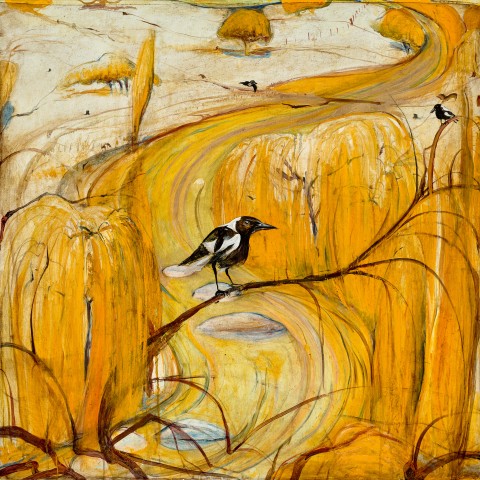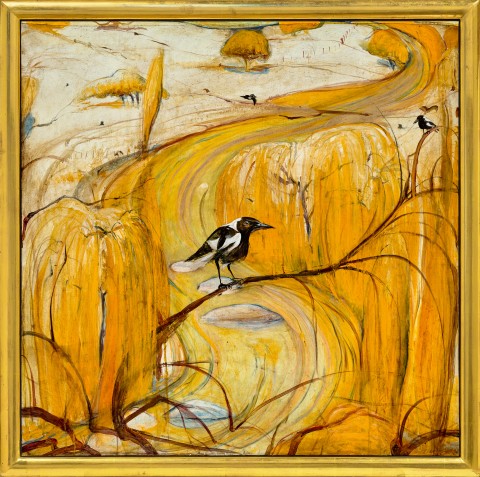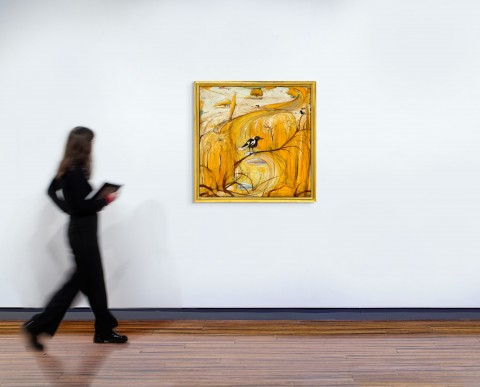(1939 - 1992)
Brett Whiteley
The magpie, 1976 - 77
oil on canvas
Robin Gibson Gallery, Sydney
Edna and Awdry Julius (Wendy Whiteley's aunt and uncle), Sydney, acquired from the above in 1977
Thence by descent
Private collection, Brisbane, 2008
Brett Whiteley - Rivers, Robin Gibson Gallery, Sydney, 1 - 19 March 1977, cat. 6
Sutherland, K., Brett Whiteley: Catalogue Raisonné, Schwartz Publishing, Melbourne, 2020, cat. 249.76, vol. 7, p. 389
It was in the familiar rolling landscapes of inland New South Wales, west of the Great Dividing Range, that Brett Whiteley, at the height of his fame, found regular solace. The landscape provided a conceptual and real escape from the realities of daily existence and the equally clamorous pressures of his successes and vices. Whenever possible, the artist, accompanied by his young family, would escape the city to rejoice in the vast open spaces and rich natural world, staying at friends’ country estates in Carcoar, Marulan and Oberon. Reconnecting with the landscape of his boyhood, whose beauty had so profoundly influenced his choice of métier, Whiteley produced some of his most acclaimed paintings, radiant with calm contemplation, lyrical lightness and keenly observed immediacy. With his signature sinuous gesture and sun-bleached autumnal palette, The magpie, 1976 – 77 belongs to a small group of riverine landscapes in the key of yellow from the late seventies including two Wynne Prize winning paintings – River at Marulan (…reading Einstein’s geography), 1976 (private collection) and Summer at Carcoar, 1977 (Newcastle Art Gallery).
Although Whiteley’s early childhood years were coloured by painful memories of a strict boarding school in Bathurst, to which he was sent at the tender age of eight, the rural location of the school provided the budding artist with a profound appreciation for the landscape that would last throughout his life. ‘The thing I loved about the school was the feeling of being close to the earth… you feel the seasons more at Bathurst than one does in the city’, he later recalled to Sandra McGrath.1 Indeed, it is the rhythms of the seasons and the tender balance of sustaining life forces that shine through in Whiteley’s later, picturesque landscapes of the central tablelands. Whiteley’s rhythmic interpretations of the sweeping, voluptuous contours of this countryside were also shaped by his enduring admiration for the celebrated landscapist of the region, Lloyd Rees. Chronologically listed in Whiteley’s catalogue raisonné alongside the multimedia River at Marulan, 1976, which was painted in situ at Glenrock, the property of architect Peter Mueller near Goulburn Valley, it is possible that The magpie was also derived from this location, sharing a similarly undulating tapestry of working paddocks. While the ‘optical ecstasy’ of the ultramarine blues of Sydney’s harbour, developed in parallel in his Lavender Bay suite, was closely tied to a specific location, Whiteley’s arid landscape dotted with poplars, weeping willows and a myriad cast of native fauna is often closely cropped, becoming universal and anonymous, a shorthand for the Australian landscape in general.
Presenting a symphony of luminous golden hues, The magpie is a seasonal landscape, swapping the yellow hues of a parched summer landscape for those of a transitional autumnal scene. Even the water of the fast-flowing river, snaking its way through the arid paddocks, reflects the saturated colours of the deciduous willows and poplars lining its banks. The riverine landscapes are variations on a theme, all featuring the same, particularly graceful S-curved section of river, winding vertically through the canvas. Bright and optimistic, The magpie is directly descended from a painting simply titled Yellow, 1975 (private collection), the first of these landscapes in this joyous colour register depicting the river as a source of life within shimmering summer heat. The curvilinear quality is finely developed in this series of mature riverine pictures, providing a dynamism to a landscape that is otherwise compressed into a vast, flattened plane. Inherently calm, and without particular narrative incident, Whiteley’s confident freehand brushstrokes describe the interlocking curves of a short segment of this meandering river and the tangle of willow trees, their fronds gracefully trailing over the water and radiating from the centre of the composition. The motif of an autumnal willow appeared frequently in Whiteley’s works. In addition to featuring alone in many works on paper, the (often golden yellow) riverside willow appears in many larger and acclaimed painted compositions of this time, including Alchemy, 1972 – 73 (Art Gallery of New South Wales); River at Carcoar, 1977 (private collection); Summer at Carcoar, 1977 (Newcastle Art Gallery); The wren, 1978 (private collection) and Autumn (Near Bathurst), 1987 – 88 (Art Gallery of New South Wales).
Despite this thematic anchoring and The magpie’s inclusion among only eleven paintings shown at Whiteley’s legendary solo exhibition ‘Rivers’ at Robin Gibson Gallery in 1977, the title of this painting would indicate that the focus should be equally directed on the bird and its nearby companion. Centrally perched in the trailing boughs of weeping willows lining the river is an Australian magpie, its striking graphic plumage painted cleanly against the swirling and sweeping lines of the flowing river. Following a disastrous trip to the United States of America, and having found a renewed love for birds during a sojourn in Fiji in 1969, throughout the 1970s Whiteley sought to rediscover the unique native beauty of Australia, creating works that recast the heroic landscape of ‘Australia Felix’ codified by Australian impressionists.2 Consequently, many of the birds that Whiteley painted within the landscape and isolated in their own compositions were specifically Australian species, at home in their native environment and becoming for Whiteley the ‘essential symbol of the song of creation’ of this antipodean paradise.3
1. Brett Whiteley, cited in McGrath, S., Brett Whiteley, Bay Books, Sydney, 1979, p. 18
2. Sutherland, K., ‘Variations on a Landscape Theme’, in Brett Whiteley: Catalogue Raisonné, Schwartz Publishing, Melbourne, 2020, p. 36
3. Pearce, B., Australian Artists, Australian Birds, Angus & Robertson, Sydney, 1989, p. 144
LUCIE REEVES-SMITH


